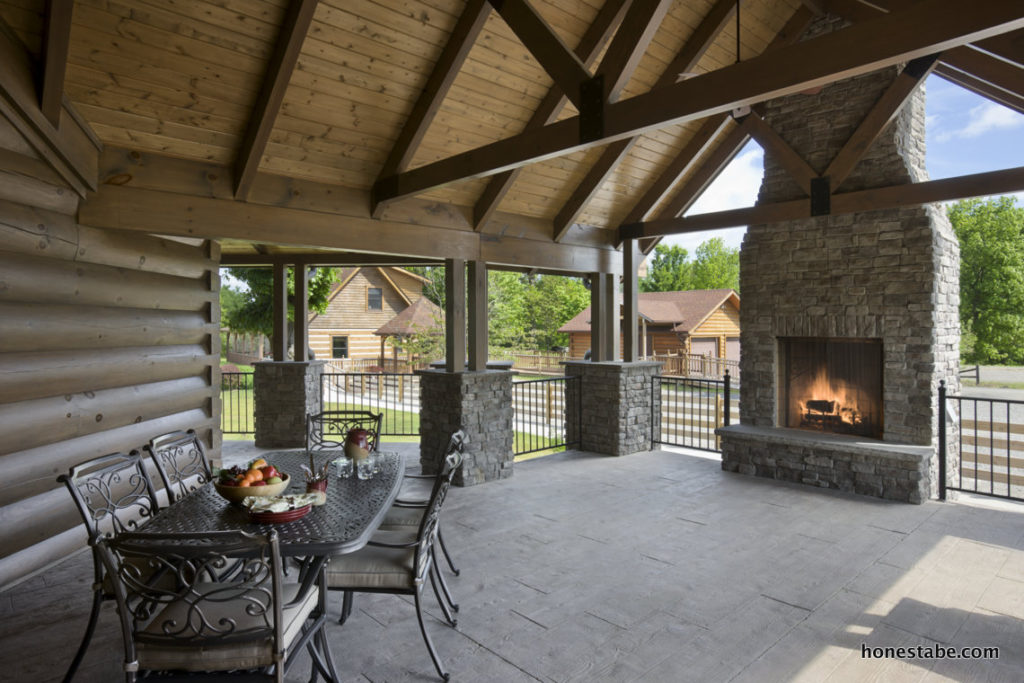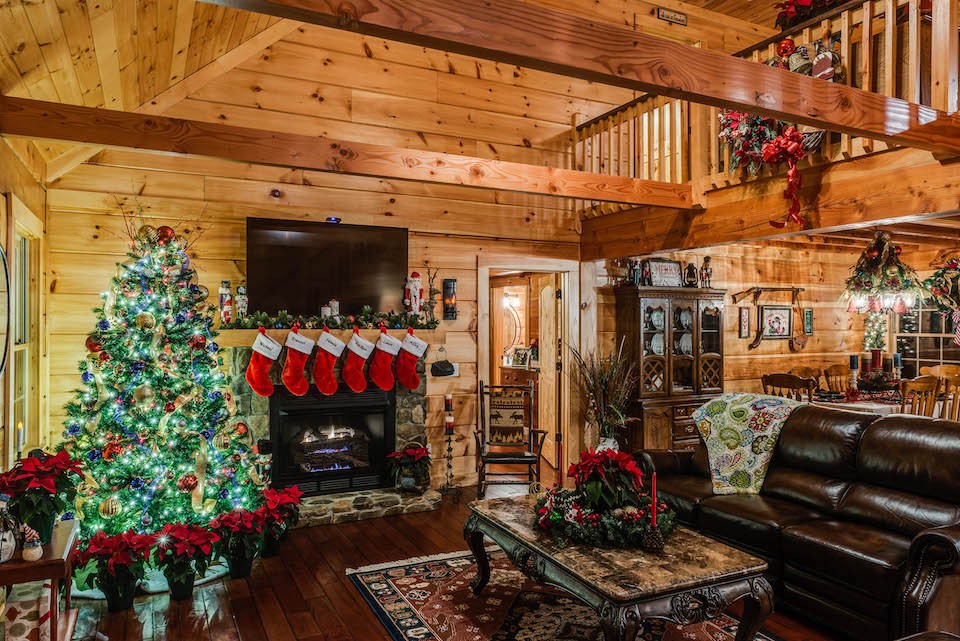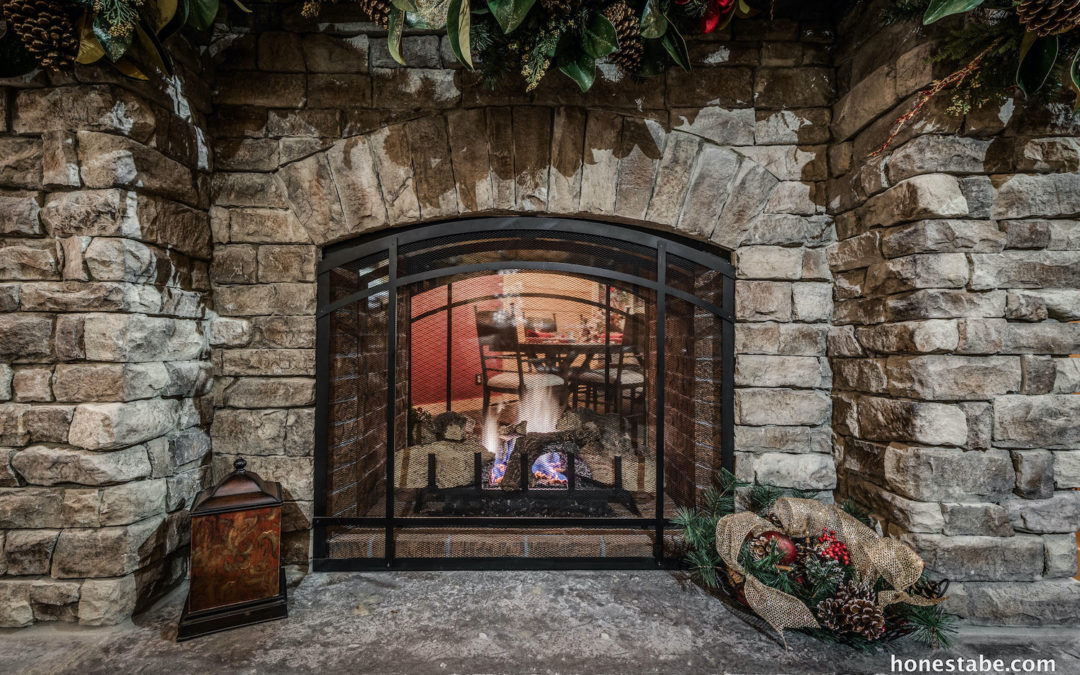It’s always nice to come home on a cold day and warm up next to a glowing fire. There’s something about a fireplace that is inviting and comforting. The flickering flames can be hypnotizing to the eye. That’s why many of Honest Abe Log Homes’ customers have fireplaces inside their own homes.
To some, there are questions that come with the decision to put a fireplace in their home. “Should I go with a gas or woodburning fireplace?” “Which kind is better for my budget?” “What are the pros and cons?”
Honest Abe would like to help with those questions and offer insight on fireplaces.
Retired Honest Abe Sales Representative Sharron Bilbrey has her very own Honest Abe log home with a traditional wood burning stone fireplace in the great room.
“The fireplace, which is the focus of our great room, is very special to us,” said Sharron. “The field stones for the fireplace were gathered from her husband’s grandfather’s land.”
Sharron said that what she enjoys most about her fireplace is the smell and crackling of the fire.
“There are so many options when it comes to fireplaces,” Sharron said. “Think more in terms if efficiency and make sure you get a professional to help you. We are considering putting a wood burning insert to make it more efficient and to be able to enjoy it more.”
Sharron was instrumental in creation of the model home completed in 2014 by Honest Abe Log Homes in Crossville, Tenn.,
“In working on some of the design options for the new Honest Abe model in Crossville we discovered a down-vent gas, see-through fireplace that used on the first floor,” Bilbrey said, referring to the fireplace pictured at the top of this page. “The venting system is much like the down-vent you use in a Jenn-Air range top. Really nice concept if you don’t want to take the pipe all the all up the wall and/or through the roof.”
There are a number of considerations with regard to including a fireplace in your log cabin or timber frame home. It’s smart to weigh the pros and cons of different types of fireplaces as you design your home. Here are two of the most common choices for home fireplaces – woodburning and gas.

1. Woodburning Fireplaces
Pros: Woodburning fireplaces have the aesthetics of a “real” fire with the smell, cracking sound and dancing flames. You get exercise from chopping wood and physically building a fire. Firewood is readily available in many areas. Wood burning fireplaces can be used as supplemental heat sources and are self-sufficient in a disaster scenario. Wood is one of the most economical, renewable, environmentally friendly fuels.
Cons: Cleaning the fireplace, emptying and hauling ashes. Woodburning fireplaces require a chimney/flue for ventilation. Inexpert use may cause odors and smoke. Fire is less autonomous than other options. There is no “on/off” switch on a wood burning fireplace. Less uniform heat output than other options. Wood storage can take significant space. Bad installation can result in dirty, ashen smoke emitted from the chimney.

2. Gas Fireplaces
Pros: Gas fireplaces burn cleaner than a wood fireplace. It’s easier to start a fire than a wood fireplace; all you have to do is flip a switch. Flexible installation options. More uniform heat output. Gas fireplaces have a more easily controlled flame height. They can be used as a supplemental heat source. Reduced requirement for human interaction with fire.
Cons: There isn’t the same ambience (smell and sound) of a wood fireplace. Less requirement for human interaction with fire. In a long power outage, it may be unusable. Fossil fuels are not environmentally friendly.
Prices
Something else to think about is comparing prices of fireplaces. Wood fireplaces can be $500 and up for materials only. A fully installed deluxe model can be as much as $5,000 to $10,000 or even more if custom-designed and using exotic materials or architecture. Gas fireplaces can range from $600 to $3,000 for the gas fireplace only. A fully installed gas fireplace ranges from $1,200 to $5,000 and up. Gas logs can be $300 to $700 for the gas logs only. Add $300 to $600 for installation into an existing fireplace. Glass fireplace door only, varying with size and type of metal and glass materials. Add $85 to $150 for installation.
Maintenance
Fireplace maintenance is very important not only for safety, but to keep your fireplace in its best working order to provide heat for your home. If there is a problem with the flue then smoke may not be able to make its way up the chimney and the smoke may enter your home creating dust, fire and possible noxious fumes. It is important to look at the manufacturers guidelines for the best service package and safety recommendations.
Employing a chimney sweep, using cleaning logs and using carbon monoxide detectors in your home is always beneficial. For a woodstove it is important that the ashes are cleaned out frequently (and disposed in a non combustible container like a metal garbage can) and for a gas fireplace it is imperative to keep it from flammable dust.
It is always worth having a safety professional look at the installation of your fireplace before lighting it for the first time, especially if you installed it yourself. There may be problems with the chimney, a blockage somewhere or if you have a gas fireplace there may be a leakage area. Fireplace safety is not to be taken lightly and fireplace maintenance is key.
Whichever kind of fireplace you might end up with, take time to decide which is best for you, but also remember to relax and enjoy it with friends and family.
Information for this story was gleaned from www.fireplacesandwoodstoves.com with the story provided by Tia Copas for Honest Abe Living.




